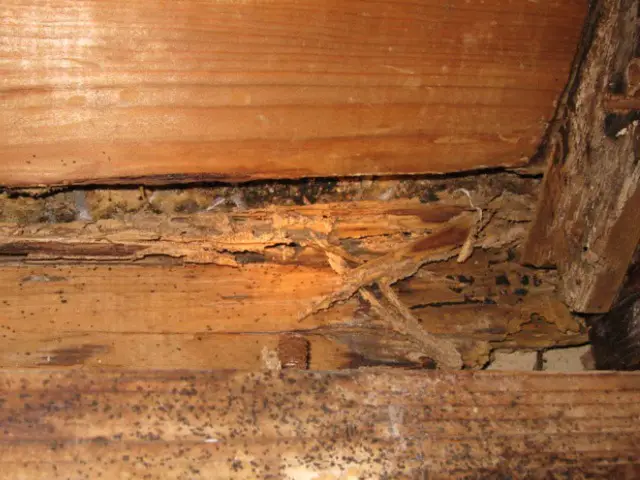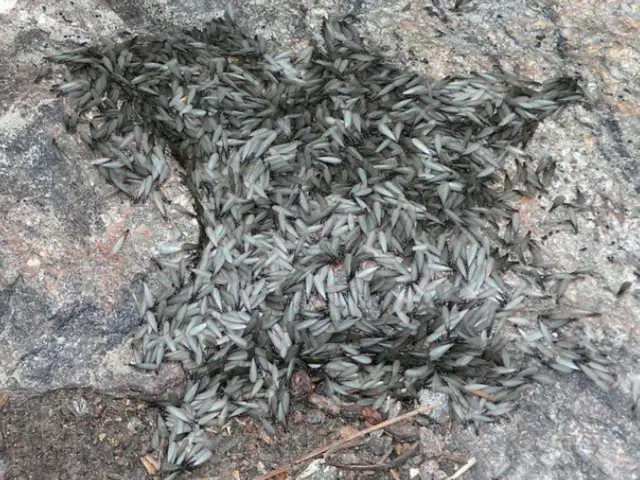Ant activity coupled with wood shavings could be the sign of a carpenter ant infestation. Before the ant colony chews through the wood structure of your house, it’s time to get your hands of carpenter ant bait and get rid of them. Even with bait, it’s not easy to get rid of carpenter ants. To apply carpenter ant bait, you might have to roll your sleeves up and drill holes in door sills, baseboards, windows, and walls. The best thing about using bait to get rid of carpenter ants is that ants voluntarily eat the toxin.
If you ever had to deal with carpenter ants, you know that baiting is the best way to get rid of these harmful pests. Carpenter ants are notorious for gnawing through the structure of homes, causing tens of thousands of dollars of damage. Depending on the size of the carpenter ant colony, the damage to the wood structure can be as devastating as that of a full-blown termite infestation. Baiting is the most effective carpenter ant control method. Liquid baits appeal to the carpenter ants’ sweet tooth. The workers will carry the bait back to the colony, getting rid of the entire colony.
What can I use as bait for carpenter ants?
Carpenter ants chew through wood, which could be the frame of your house. Bait is made to taste like a natural food for ants, so it’s enticing for carpenter ants.
Related post:
- How To Get Rid Of Ants in Florida?
- How To Get Rid Of Ants in New York?
- How To Get Rid Of Ants in Texas?
- How To Get Rid Of Ants In Illinois?
- How To Get Rid Of Ants In Ohio?
- What Are The Early Signs Of Termite Damage?
- Can You Get Rid Of Termites Without Tenting?
You can use a wide variety of bait to get rid of carpenter ants:
- Powder carpenter ant bait
- Granular carpenter bait
- Liquid carpenter ant bait
- Gel ant bait
- Self-adhesive ant bait
What is ant bait?
Carpenter ant bait is a mixture of natural food that attracts ants and an insecticide (toxic chemical). Carpenter ants come into contact with the bait as the workers are looking for food. Ant baits are available in many forms, and some are more effective than others.
What makes good carpenter ant bait?
A good carpenter ant bait will get rid of ants instead of splitting the colony into multiple colonies. But, using the wrong ant control techniques can make the ant problem worse. So, what makes a good carpenter ant bait? The best carpenter ant bait is easy to use. And, it’s filled with poison and eliminates the entire carpenter ant colony.
Does ant bait really work?
Carpenter ant bait really works. It traps carpenter worker ants with either sugar or some other natural food source for ants. The bait has been treated with a small dose of toxic ingredients. Even natural baits can get rid of carpenter ants. Baits take time. The process generally requires worker ants to make multiple trips between the ant bait and the colony.
Baits work even when you don’t know where the ant nest is located. Sometimes you might know where the colony is located, but you cannot get access to it. You can use bait even if the colony is out of reach. Ant bait poses less risk to children, pets, and other animals. And it kills the entire colony whereas insect sprays generally require direct contact to work. Also, some repellents don’t kill the ants, so they only provide a temporary solution that is less effective.
The biggest disadvantage of ant bait is that until the workers discover it, you cannot use it to get rid of ants in the yard. Unfortunately, not all baits are attractive to ants. You can test small quantities of bait to see if the workers take it. If the bait is unacceptable to the workers, you should get another bait.
What are the requirements for ant bait to work?
- The worker ant must find the bait. Please the bait in areas of ant activity. It’s critical to place carpenter ant bait out of the reach of kids, wildlife and pets. Keep bait out of areas of food preparation.
- Deliver small quantities of the bait back to the colony. Even though each worker only takes a small amount of bait, you need to make sure that you use enough bait. If the bait is depleted too soon, the workers will search for food elsewhere. Also, make sure to have the bait in place for at least a few days.
- Feed the bait to the queens, brood and other workers. The process will take at least a few days, so you need to be patient. Many baits don’t kill the ants immediately. Even if the bait works, you may see carpenter ants for weeks.
- Attract more workers to the bait. For the bait to work, it has to attract more and more workers. The more workers discover the bait the faster it will eliminate the colony.
Powder Carpenter ant bait
Borax, a white powder, is a safe yet effective carpenter ant bait. It’s a relatively safe ant bait. You can find the same stuff in laundry detergent. Borax has been used as an ant bait for decades. It can be mixed with sugary liquids to create a yummy meal for a carpenter ant colony.
Liquid carpenter ant bait
Carpenter ants are attracted to and will feed on liquid ant bait until they die. After they eat the bait, the carpenter ants will return to the colony. The workers will feed that bait to their young and the queens, killing the entire colony. Liquid ant bait has delayed action, allowing it to kill the queen and the colony. Did you know that the carpenter ant queen can live up to 25-years?
Carpenter ant spray
The fastest way to get rid of carpenter ants is to use an ant spray. If you want to get rid of carpenter ants instantly, use an ant control spray. Make sure you buy a carpenter ant spray that is for both indoor and outdoor use. One of the best things about using a spray to get rid of ants is that it’s is easy to use. Just point and spray. One thing that most people hate about using an ant spray is the choking smell.
What is the best time to spray for carpenter ants?
The best time to spray carpenter ants is during the night. That’s because carpenter ants are the most active during the night.
Carpenter ant bait gel
A carpenter ant bait gel can eliminate your ant problem fast and easily. The gel bait entices worker ants to carry the poison directly to the queen and the rest of the ant colony. Bait gels are manufactured with an easy application plunger, simplifying bait placement. Carpenter ant bait gel doesn’t come with bait stations, so they are not child and pet-safe out of the box. However, bait gels can get rid of an entire carpenter ant colony in a matter of days.
Carpenter ant bait traps
Some carpenter ant bait traps come with adhesive strips. The strips are used for mounting the carpenter ant bait traps to vertical surfaces like kitchen cabinets. The self-adhesive feature offers more options for homeowners for bait trap placement. It can also help you keep these ant traps out of the reach of small children and pets. Carpenter ant bait traps generally ship with a syrup that attracts ants.
How long does it take to kill a carpenter ant colony with bait?
Bait can kill a carpenter ant colony in a matter of days or weeks. How long it takes to get rid of the carpenter ant colony depends on the size of the colony. Generally, an ant the consumes the bait will die in less than 24-hours.
Where to place carpenter ant bait?
Place carpenter ant bait close to areas of ant activity. Ant bait will be most effective near kitchen cabinets, under and behind appliances, drains, and in wall openings like outlets and around pipes.
Carpenter ant facts
- Carpenter ants are extremely strong insects. They can lift up to seven times their body weight. What’s makes this carpenter ant fact even more impressive is that they can lift all that weight with their teeth. The main reason carpenter ants can lift so much weight is that they are mostly muscle.
- Carpenter ants are some of the largest ants in the United States. They can reach up to three-quarters of an inch in length.
- Carpenter ants will bite to defend their nest. These insects inject formic acid into your skin, making their bite even more painful.
- Carpenter ants disinfect their nests with the resin they collect.
- These ants are tidy. Carpenter ants remove dead ants and old wood from their nest.
- Carpenter ants are easily confused with termites. The big difference between carpenter ants and termites is that carpenter ants don’t eat wood, they just chew it. While termites will eat the wood your house is built on, carpenter ants will chew tunnels to provide them a place to live.
- This ant follows pheromone trails other ants secrete. In essence, carpenter ants sniff – they don’t have noses, they use their antennas – out the right path forward.
Carpenter ants are possibly one of the most underestimated wood-destroyers in the U.S. The carpenter ant is both a nuisance and with potential for extensive wood damage. This type of ant varies in size from medium to large, and the color varies also, may be brown, reddish, or black.
Carpenter ants are nocturnal, preferring to forage at night. Therefore, sightings during the day, even a few every day, may serve as evidence of an established ant infestation. They nest in many different areas and materials, from insulation(fiber, foam and wood composite), sub-roofing, soil to structural wood such as headers, joists, studs, jack studs, cripple studs, and window sills etc.
They start in moist areas but can and will spread into sound wood in adjacent areas. The nest sites are usually in wall voids or behind finished and hard to get to places, so they will not be readily visible in most cases. True eradication of carpenter ants requires a comprehensive approach that deals with all conducive areas while taking special measures in your home’s hotspots; these spots are determined by an inspection and a few questions from the pest control inspector.




